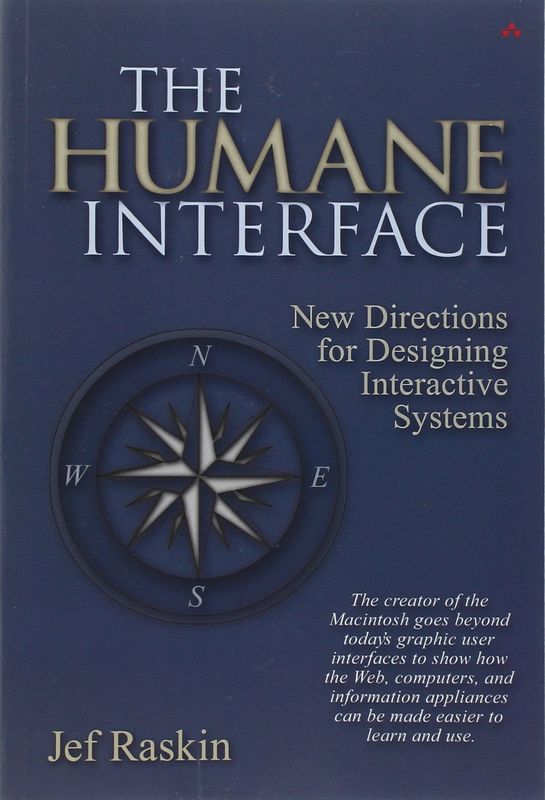The Humane Interface Book Summary
In 'The Humane Interface,' Jef Raskin revolutionizes the way we think about human-computer interaction. He argues for an interface that is intuitive and seamlessly fits into our natural behaviors, rather than forcing users to adapt to clunky software. Raskin introduces groundbreaking concepts that challenge conventional design principles and aims to enhance user satisfaction. As technology becomes more pervasive, his insights reveal how humane design can create a deeper connection between humans and machines. Dive into this thought-provoking read and discover how a user-centered approach can transform our digital experiences!
By Jef Raskin
Published: 2000
""The most important question to ask when designing an interface is not what it can do, but what it should do for its users.""
Book Review of The Humane Interface
Cognetics and the locus of attention - Meanings, modes, monotony, and myths - Quantification - Unification - Navigation and other aspects of humane interfaces - Interface issues outside the user interface.
Book Overview of The Humane Interface
About the Book Author
Jef Raskin
Jef Raskin was a pioneering computer scientist and author, best known for his work in human-computer interaction and as the creator of the Apple Macintosh project. His notable works include 'The Humane Interface,' where he emphasized the importance of user-centered design, and 'The Raskin: A Child's Guide to Fire and Water,' demonstrating his ability to convey complex ideas in an accessible manner. Raskin's writing style is characterized by clarity, precision, and a focus on simplifying technology to enhance user experience.
Book Details
Key information about the book.
- Authors
- Jef Raskin
- Published
- January 2000
- Publisher
- Addison-Wesley Professional
- ISBN
- 0201379376
- Language
- English
- Pages
- 278
- Genres
- UX/UI DesignTechnologyDesign
Purchase Options
Support local bookstores: BookShop gives a portion of each sale to independent bookshops!
Similar books you might like →
Cultural Strategy Book Summary
In "Cultural Strategy," Douglas Holt and Douglas Cameron reveal the secret to building powerful brands that resonate deeply with consumers. They argue that brands must transcend mere products to become cultural icons by leveraging the stories and values that shape society. The authors outline a framework for understanding cultural movements and how to align brand strategies with these shifts. Through compelling case studies, they illustrate how successful brands capture the zeitgeist and actively participate in cultural conversations. This book is a game-changer for marketers eager to forge meaningful connections with their audience.
Modern Engineering for Design of Liquid-propellant Rocket Engines Book Summary
Dive into the cutting-edge world of rocketry with 'Modern Engineering for Design of Liquid-propellant Rocket Engines.' This authoritative guide unveils the complexities of liquid-propellant systems, blending theory with practical applications. Discover the intricacies of engine design, from thermodynamics to fluid mechanics, that drive today's space exploration. Written by experts in the field, this book demystifies the engineering behind launching mankind to the stars. Are you ready to propel your understanding of rocket science to new heights?
Don't Make Me Think, Revisited Book Summary
In 'Don't Make Me Think, Revisited', Steve Krug presents a timeless guide to web usability, challenging the notion that users read websites thoroughly. With humor and clarity, he emphasizes the importance of intuitive design, advocating that simplicity trumps complexity. Krug's insights encourage designers to prioritize user experience, making navigation as effortless as possible. Through practical examples and actionable advice, he unveils common pitfalls to avoid. This essential read will transform the way you think about designing websites and engaging users—are you ready to rethink your approach?
100 Things Every Designer Needs to Know about People Book Summary
In '100 Things Every Designer Needs to Know about People,' Susan Weinschenk unveils essential psychological principles that can enhance design effectiveness. With insights drawn from cognitive science, the book explores how people perceive, interact with, and make decisions about design. From the nuances of color perception to the importance of empathy in user experience, Weinschenk offers practical strategies for designers. Each principle is supported by fascinating research, making the content both informative and engaging. This enlightening guide equips designers to create more intuitive and user-friendly experiences, sparking curiosity about the intersection of psychology and design.
What Technology Wants Book Summary
In "What Technology Wants," Kevin Kelly delves into the deep interplay between humanity and technology, suggesting that technology is an extension of life itself. He argues that just like biological evolution, technology has its own agenda and desires, shaping our future in profound ways. Through a blend of philosophical insights and real-world examples, Kelly reveals how technological advancements reflect our aspirations and fears. As he explores the notion of 'the technium'—a vast, interconnected web of technology—readers are invited to reconsider their relationship with the tools they create. This thought-provoking journey challenges us to embrace technology as a living entity that influences and drives our evolution.
Sketching User Experiences: Getting the Design Right and the Right Design Book Summary
No summary available
The Elements of Scrum Book Summary
Delve into the transformative world of Scrum with 'The Elements of Scrum,' where authors Chris Sims and Hillary Louise Johnson unravel the principles that drive agile project management. This insightful guide not only explains the core components of the Scrum framework but also illustrates how they can revolutionize teamwork and productivity. Through vivid examples and practical tips, you’ll discover how to foster collaboration and innovation in any environment. Whether you’re a novice or a seasoned practitioner, the book challenges conventional approaches and ignites a passion for continuous improvement. Are you ready to embrace agility and unleash your team's potential?
Gamification by Design Book Summary
In 'Gamification by Design', the authors explore the art and science of integrating game mechanics into non-game contexts to enhance user engagement and motivation. They uncover the psychology behind what makes games addictive and how these principles can be applied to real-world scenarios. Through practical case studies and actionable frameworks, the book reveals how gamification can be a catalyst for innovation and user loyalty. Are you ready to unlock the secrets of game mechanics and transform your projects? Dive into this insightful read to discover how to design experiences that captivate and retain users!
Showing 8 of 24 similar books
Similar Book Recommendations →

Melanie Perkins's Book Recommendations
Melanie Perkins is an Australian technology entrepreneur and the co-founder and CEO of Canva, an online design and publishing tool that has revolutionized the graphic design industry. Born in Perth, Australia, she launched Canva in 2013 with the aim of making design accessible to everyone, regardless of their skill level. Under her leadership, Canva has grown to serve millions of users worldwide and has reached a multi-billion-dollar valuation. Perkins' innovative approach and dedication to user-friendly design have earned her recognition as one of the most influential women in technology. Beyond her entrepreneurial success, she is also a passionate advocate for diversity and inclusion in the tech industry.

Johnnie Gomez's Book Recommendations
Johnnie Gomez is an acclaimed author known for their compelling narratives and richly developed characters. Their debut novel, *Echoes of the Past*, garnered critical praise and won the prestigious Booker Prize, establishing Gomez as a powerful new voice in contemporary fiction. They followed this success with *Winds of Change*, a novel that deftly explores themes of identity and resilience, earning a spot on the New York Times Bestseller list. Gomez's contributions to literature have been celebrated for their insightful portrayal of diverse cultures and their ability to weave intricate, emotionally resonant stories. Beyond their novels, Gomez is a vocal advocate for literacy and education, frequently engaging with communities through workshops and public speaking events.

John Doerr's Book Recommendations
John Doerr is an American venture capitalist and chairman of Kleiner Perkins, one of the most prominent venture capital firms in Silicon Valley. Doerr has backed some of the biggest names in tech, including Google, Amazon, and Netscape, and has played a crucial role in the rise of the internet economy. He is also the author of Measure What Matters, which popularized the concept of Objectives and Key Results (OKRs) as a method for goal-setting in organizations. Doerr is a passionate advocate for addressing climate change and has invested in clean energy startups to help combat global warming. His contributions to tech and sustainability have made him a leading figure in venture capital.

Jan Losert's Book Recommendations
Jan Losert is a visionary author and digital design expert, renowned for his contributions to the intersection of technology and creativity. His most significant work includes co-authoring "Design Systems Handbook," which has become a seminal guide for creating cohesive and efficient design frameworks. Losert's expertise extends to his role as a speaker and educator, where he passionately shares his insights on user experience and interface design. In addition to his literary achievements, he co-founded several successful startups, leveraging his deep understanding of design to drive innovation. His work continues to influence and inspire both emerging and established designers worldwide.

Bret Victor's Book Recommendations
Bret Victor is a renowned American interface designer and computer scientist celebrated for his innovative contributions to interactive design and human-computer interaction. He is best known for creating dynamic, explorable explanations, which have significantly influenced the way educational content is presented and understood. Victor's seminal work, "Inventing on Principle," advocates for the integration of immediate feedback in creative processes, inspiring a new wave of interactive programming environments. As a former member of the Apple Human Interface team, he played a pivotal role in shaping modern user interfaces. Through his organization, Dynamicland, Victor continues to explore and expand the boundaries of immersive, collaborative computing environments.

George Hatzis's Book Recommendations
George Hatzis is a lawyer, entrepreneur, and social media content creator known for his humorous and insightful takes on the legal profession. Through his popular Instagram account, Hatzis shares legal memes, advice, and commentary, making complex legal topics accessible and entertaining for a broad audience. He is also the founder of Hatzis Law, a firm that specializes in criminal defense and family law. Hatzis’ ability to merge legal expertise with humor has garnered him a large following, and he continues to be a unique voice in the legal community, advocating for modernizing the industry.

Ben Silbermann's Book Recommendations
Ben Silbermann is the co-founder and former CEO of Pinterest, the popular image-sharing and social media platform. Launched in 2010, Pinterest has grown into a global platform used by millions to discover and share ideas and inspiration. Silbermann’s background in product design and user experience helped shape Pinterest’s visually driven and user-friendly interface. He has stepped down as CEO but remains active in the company’s direction and strategy. His work has made him a significant figure in tech and social media innovation.

John Maeda's Book Recommendations
John Maeda is a designer, technologist, and thought leader known for his work at the intersection of technology, design, and leadership. A former president of the Rhode Island School of Design (RISD), Maeda has been a strong advocate for integrating art and design with technology to drive innovation. He is currently the Chief Technology Officer at Everbridge and has previously held leadership roles at Automattic (the parent company of WordPress) and KPCB, a venture capital firm. Maeda’s work explores the role of creativity in technology, and he is known for his insightful talks and books, including The Laws of Simplicity and Redesigning Leadership. He has been instrumental in promoting the idea of “design thinking” in business and has influenced a generation of designers and technologists to approach problem-solving with creativity. Maeda is also a prolific speaker, frequently sharing his ideas on the future of design and its role in shaping the modern world.
Showing 8 of 14 related collections
“"The most important question to ask when designing an interface is not what it can do, but what it should do for its users."”
The Humane Interface
By Jef Raskin
Frequently Asked Questions
Explore Our Catalogue
Discover a world of knowledge through our extensive collection of book summaries.
Genres
Genres
Genres
Featured Collections
- Top Book Club Picks
- One-Stop Nutrition
- Summer Reads 2024
- Best Beach Reads 2024
- Work-Life Balance Guide
- Time Management
- Healthy Foods
- Entrepreneur Toolkit
- Mind & Body Wellness
- Future Tech Insights
- Leadership Essentials
- Financial Freedom
- Sci-Fi Masterpieces
- Parenting 101
- Books That Became Blockbusters
- Guide to a Healthy Pregnancy










